Holistic Yoga Practices for Perimenopause and Menopause Relief
Yoga: A Holistic Approach to Menopause Management
Perimenopause and menopause are significant phases in a woman’s life, marked by various physical and emotional changes. While these transitions can bring about challenges such as hot flashes, mood swings, and sleep disturbances, integrating yoga into your daily routine can provide immense relief. This article delves into the benefits of yoga for menopause and perimenopause, highlights specific yoga poses for menopause hot flashes, and offers a holistic guide to menopause yoga exercises.
Understanding Perimenopause and Menopause
Perimenopause is the transitional period leading up to menopause, typically beginning in a woman’s 40s but sometimes starting earlier. During this phase, the production of estrogen and progesterone fluctuates, causing symptoms such as irregular periods, hot flashes, night sweats, and mood changes. Menopause is defined as the point when a woman has gone 12 consecutive months without a menstrual period, marking the end of reproductive years. Common symptoms during menopause include hot flashes, vaginal dryness, sleep disturbances, and anxiety.
The Role of Yoga in Menopause and Perimenopause

Yoga is an ancient practice that combines physical postures, breathing exercises, and meditation. It promotes physical, mental, and emotional well-being, making it an ideal approach for managing the symptoms of perimenopause and menopause. Here’s how yoga can help:
1. Reducing Hot Flashes
Yoga poses that promote relaxation and regulate the nervous system can significantly reduce the frequency and intensity of hot flashes.
2. Improving Sleep
Yoga enhances sleep quality by reducing stress and promoting relaxation.
3. Balancing Mood
The mindful nature of yoga helps in managing mood swings and anxiety.
4. Boosting Energy Levels
Regular practice of yoga can combat fatigue and increase overall energy.
5. Strengthening Bones
Weight-bearing yoga poses help maintain bone density, which is crucial during menopause when the risk of osteoporosis increases.
Yoga Poses for Menopause Hot Flashes
Hot flashes are one of the most common and distressing symptoms of menopause. Certain yoga poses can help cool the body and calm the mind, providing relief from these sudden heat surges. Here are some effective yoga poses for menopause hot flashes:
1. Supported Bridge Pose (Setu Bandhasana)

- How to Do It: Lie on your back with your knees bent and feet flat on the floor. Place a block or bolster under your sacrum for support. Lift your hips and relax your arms by your sides.
- Benefits: This pose helps open the chest, improves circulation, and promotes relaxation, which can alleviate hot flashes.
2. Legs Up the Wall Pose (Viparita Karani)
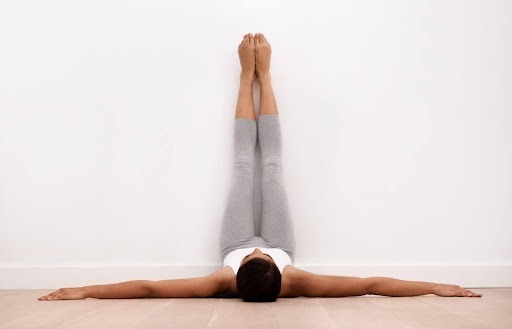
- How to Do It: Sit close to a wall and swing your legs up to rest vertically against it. Your hips should be close to the wall. Relax your arms by your sides and breathe deeply.
- Benefits: This restorative pose cools the body, reduces anxiety, and improves circulation.
3. Child’s Pose (Balasana)
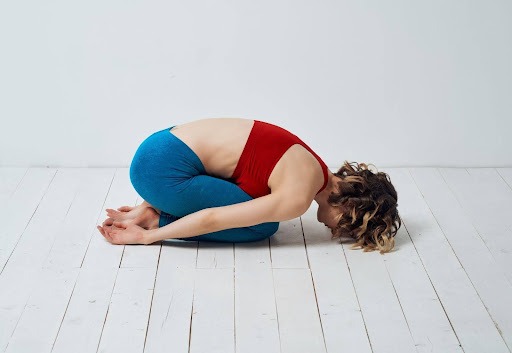
- How to Do It: Kneel on the floor, sit back on your heels, and fold forward, extending your arms in front of you or resting them by your sides. Rest your forehead on the mat.
- Benefits: The child’s pose is calming and grounding, helping to reduce stress and manage hot flashes.
Yoga Poses for Perimenopause
Perimenopause can bring about a variety of symptoms that yoga can help manage. Here are some beneficial yoga poses for perimenopause:
1. Warrior II (Virabhadrasana II)
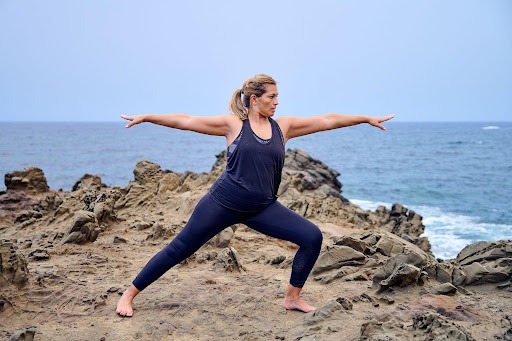
- How to Do It: Stand with your feet wide apart, turn your right foot out, and bend your right knee. Extend your arms parallel to the floor and gaze over your right hand. Hold and then switch sides.
- Benefits: This pose strengthens the legs, improves balance, and boosts confidence and energy levels.
2. Tree Pose (Vrikshasana)
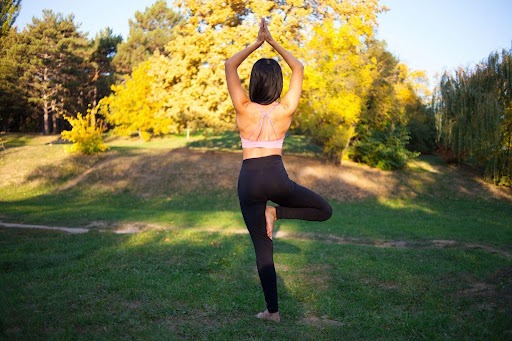
- How to Do It: Stand tall and shift your weight onto your left foot. Place your right foot on your inner left thigh or calf (avoid the knee). Bring your hands together in a prayer position at your chest or extend them overhead.
- Benefits: Tree pose enhances balance and concentration, promoting a sense of stability and calm.
3. Cat-Cow Pose (Marjaryasana-Bitilasana)
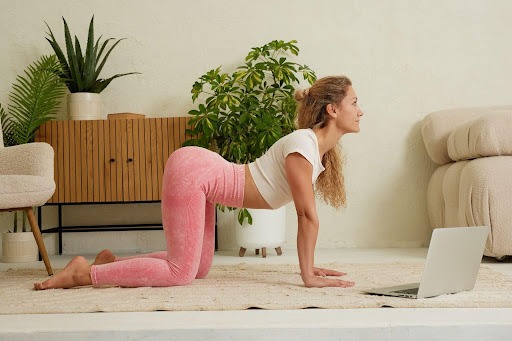
- How to Do It: Start on your hands and knees in a tabletop position. Inhale, arch your back (cow pose), and exhale, round your spine (cat pose). Move smoothly between these positions.
- Benefits: This gentle flow increases flexibility in the spine and relieves tension in the back and neck.
Menopause Yoga Exercises
In addition to specific poses, integrating a routine of menopause yoga exercises can significantly improve overall well-being. Here’s a simple sequence to follow:
Morning Routine to Energize
- Sun Salutations (Surya Namaskar): Perform 5-10 rounds to wake up the body and mind.
- Warrior II (Virabhadrasana II): Hold each side for 5 breaths.
- Tree Pose (Vrikshasana): Hold for 5 breaths on each side.
Midday Routine to Manage Stress
- Seated Forward Bend (Paschimottanasana): Sit with your legs extended and fold forward from the hips.
- Bridge Pose (Setu Bandhasana): Hold for 5-10 breaths.
- Legs Up the Wall (Viparita Karani): Rest in this pose for 5-10 minutes.
Evening Routine to Promote Relaxation
- Child’s Pose (Balasana): Hold for 5-10 breaths.
- Reclining Bound Angle Pose (Supta Baddha Konasana): Lie on your back with your feet together and knees apart. Hold for 5-10 minutes.
- Savasana (Corpse Pose): End your practice with 5-10 minutes of deep relaxation.
Breathing Exercises and Meditation
Incorporating breathing exercises (pranayama) and meditation into your yoga practice can enhance its benefits. Here are some techniques:
1. Cooling Breath (Sheetali Pranayama)

- How to Do It: Sit comfortably, roll your tongue into a tube, and inhale through your mouth. Close your mouth and exhale through your nose.
- Benefits: This breath cools the body and calms the mind, making it effective for hot flashes.
2. Alternate Nostril Breathing (Nadi Shodhana)
- How to Do It: Sit comfortably, close your right nostril with your thumb, and inhale through the left nostril. Close the left nostril with your ring finger, release the right nostril, and exhale through the right nostril. Repeat on the other side.
- Benefits: This practice balances the nervous system, reduces stress, and promotes mental clarity.
3. Mindfulness Meditation
- How to Do It: Sit or lie down comfortably, close your eyes, and focus on your breath. Observe your thoughts without judgment and bring your attention back to your breath.
- Benefits: Mindfulness meditation reduces anxiety, improves mood, and enhances overall well-being.
Key Takeaway
Using yoga to manage menopause and perimenopause is holistic and natural. Yoga poses for menopause hot flashes, mind-body exercises, and targeted breathing practices can help alleviate the physical pains and mental problems of women. By incorporating yoga into your everyday life, you will be enhancing your overall well-being which will help you transition to perimenopause and menopause with dignity and strength.
Consistency is important. Even a few minutes of yoga every day can make a big difference. Make sure you always pay attention to your body’s needs while in a pose so that the practice remains safe and comfortable at all times. By embracing this practice, one finds stability, serenity as well as robustness during this metamorphic moment in life.
Apart from practicing yoga, it is also important to maintain a healthy lifestyle by eating a well-balanced diet, staying hydrated, and exercising regularly. In addition, these practices combined with yoga could help alleviate the symptoms that come with perimenopausal or menopausal stages of life leading to healthier more satisfying lives.
Join Miror Network
Do you need more support as well as resources on how to deal with perimenopause? Then why don’t you join our community where you can access other ladies who are going through this phase? Our community offers:
- Exclusive access to expert-led sessions tailored for menopause and perimenopause.
- A supportive network where you can share experiences and find encouragement.
- Regular updates on the latest research and tips for managing symptoms naturally.
- Access to perimenopause and menopause experts across specialties.
Join today and start your journey towards a healthier, more balanced life with the support of our vibrant community.




